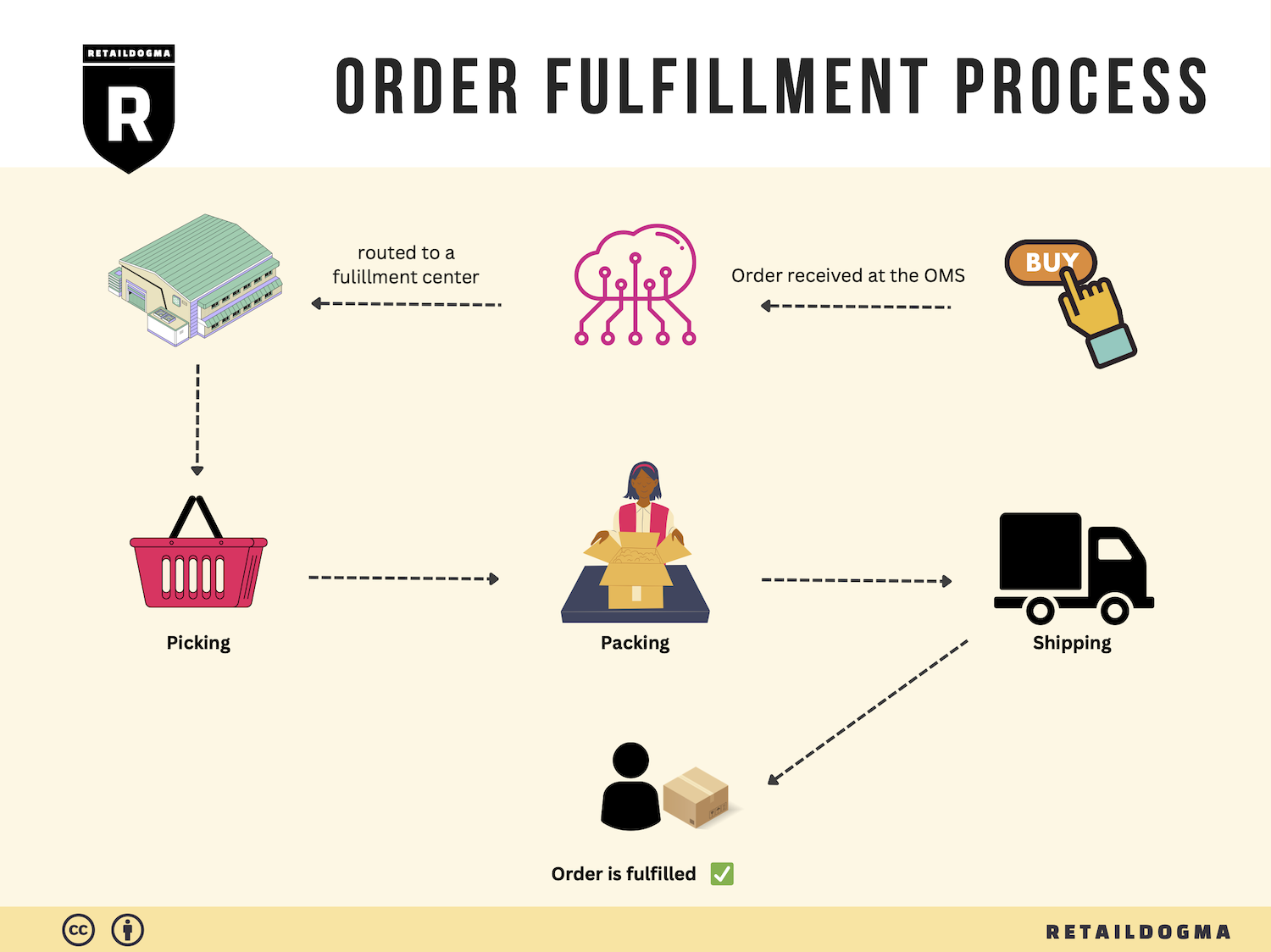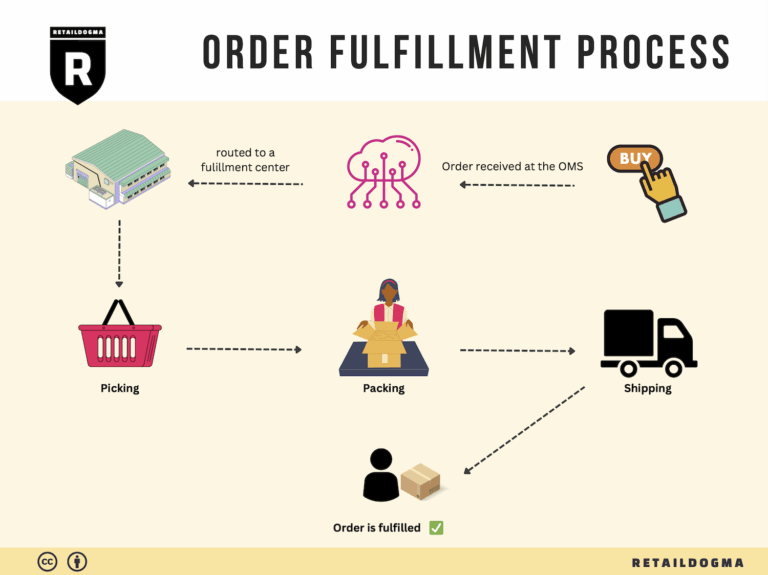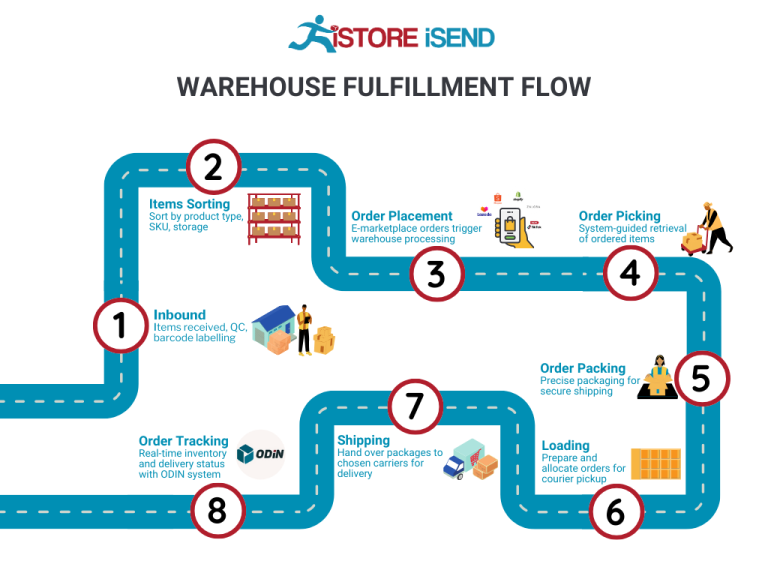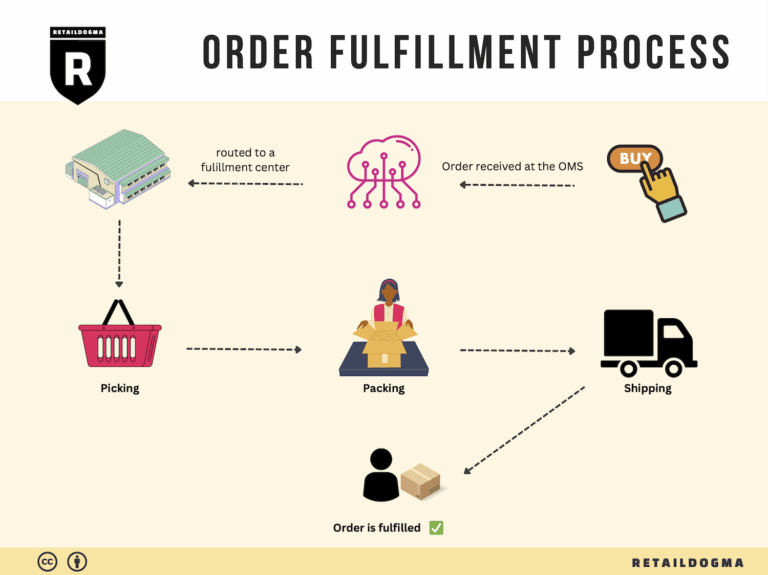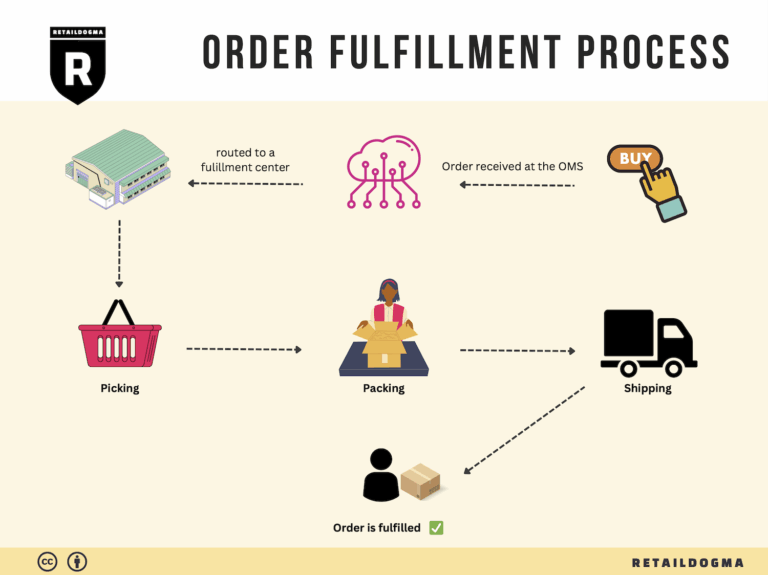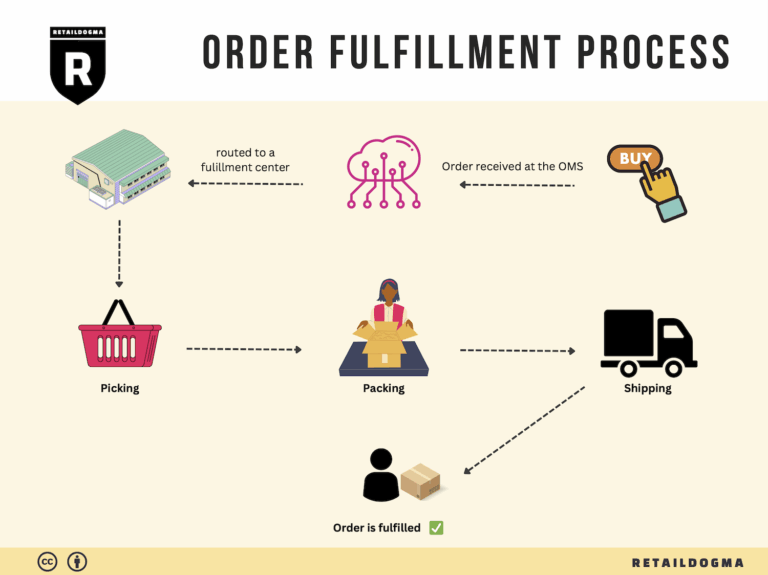How Order Fulfillment Works: A Step-by-Step Guide for Businesses
What is E-commerce Fulfillment? An Introduction for Growing Businesses
Understanding E-commerce Fulfillment
As an online business owner, you may often find yourself overwhelmed with the logistics of packing and shipping orders. Handling fulfillment can be a daunting task, especially as your sales volume increases. The process of getting a product from your inventory to your customer’s doorstep involves multiple steps, including order processing, picking, packing, shipping, and managing returns. This is where effective e-commerce fulfillment becomes essential.
E-commerce fulfillment is simply the process of receiving, processing, and delivering orders to customers. It encompasses everything from inventory management to shipping logistics, and it’s critical for maintaining customer satisfaction and loyalty. As your business grows, understanding the intricacies of fulfillment can help you streamline operations, reduce costs, and enhance your overall service quality.
In this guide, we will explore various fulfillment models that can cater to your growing business needs. You’ll learn about Third-Party Logistics (3PL) providers, which can handle warehousing and shipping on your behalf, and Fulfillment by Amazon (FBA), which allows you to leverage Amazon’s vast logistics network to reach customers efficiently. Each model has its own set of advantages and considerations, and we’ll help you determine which option might be the best fit for your business.
We’ll also cover the core services involved in fulfillment, such as inventory management, order processing, packing, shipping, and returns handling. Understanding these services will enable you to identify what you need from a fulfillment partner to support your operational goals.
Choosing the right fulfillment partner is crucial. We will provide practical tips on how to evaluate potential partners based on their capabilities, technology, location, and customer service. Additionally, we will discuss pricing structures, helping you understand how to navigate costs and find a solution that fits within your budget while still delivering quality service.
The goal of this guide is to empower you with the knowledge needed to make informed decisions about your logistics strategy. By mastering the fulfillment process, you can focus on what you do best—growing your business—while ensuring your customers receive their orders promptly and accurately. Let’s dive in and explore how effective e-commerce fulfillment can be a game-changer for your growing business.
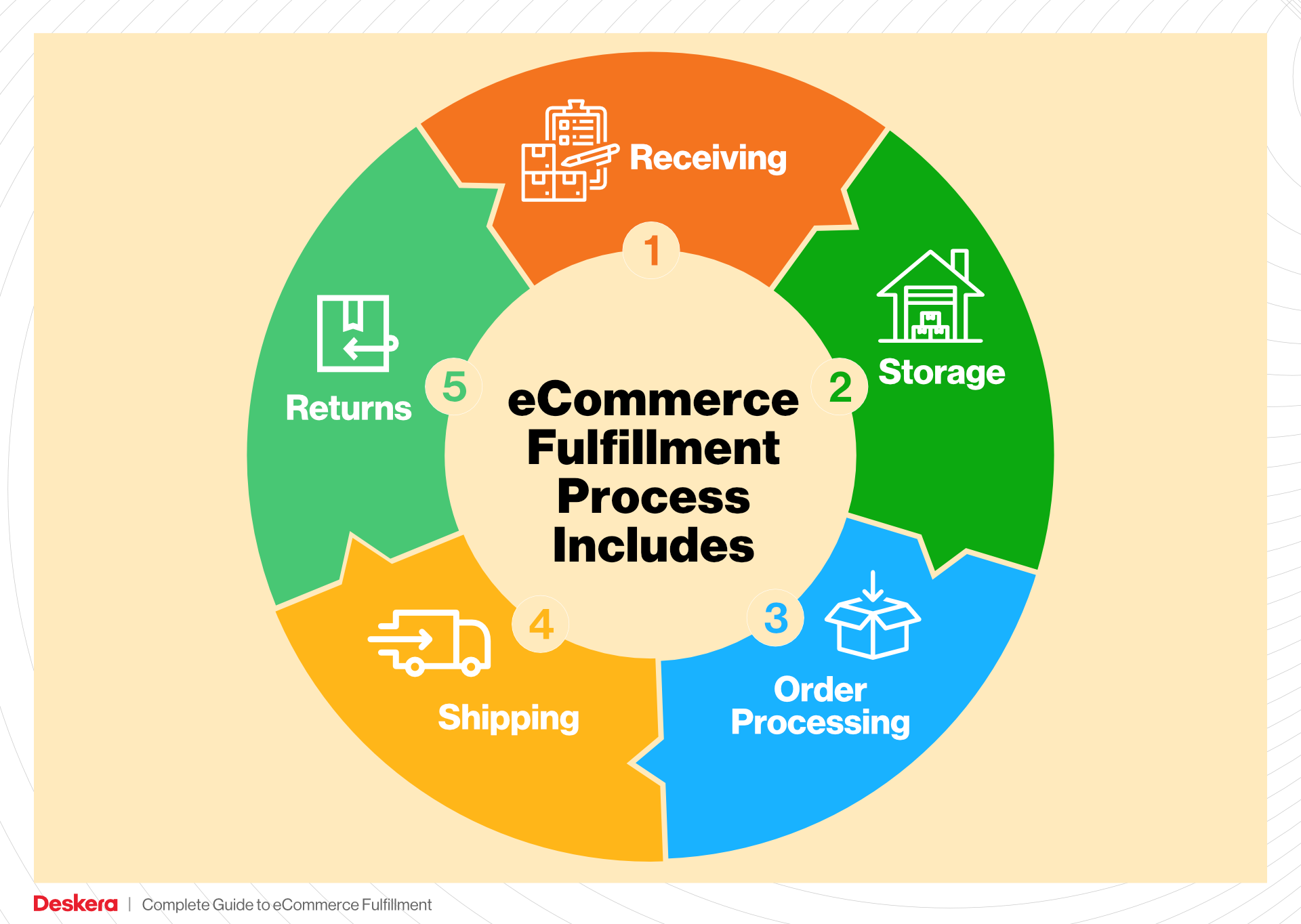
What You’ll Learn In This Guide
- What is E-commerce Fulfillment? An Introduction for Growing Businesses
- The Order Fulfillment Process: From ‘Buy’ Button to Customer’s Door
- Comparing Fulfillment Models: In-House vs. 3PL vs. Dropshipping
- A Deep Dive into Amazon FBA: Pros, Cons, and Who It’s For
- Core Services Offered by Fulfillment Centers
- How to Choose a Fulfillment Partner: A 6-Point Checklist
- Understanding Fulfillment Pricing: A Breakdown of Common Fees
- Frequently Asked Questions (FAQs) about Fulfillment
- Conclusion: Is Outsourcing Fulfillment the Right Move for Your Business?
- Important Disclaimer
The Order Fulfillment Process: From ‘Buy’ Button to Customer’s Door
1. Receiving Inventory
The order fulfillment process begins with receiving inventory, a crucial step that sets the stage for efficient operations. When products arrive at the fulfillment center, they are checked against purchase orders to ensure accuracy and quality. This process typically involves scanning items using a unique identifier known as the Stock Keeping Unit (SKU), which allows for precise tracking and inventory management.
This step is essential for several reasons: it prevents discrepancies, reduces the likelihood of stockouts, and ensures that only quality products are available for sale. Accurate receiving also helps maintain a clear record of inventory levels, which is vital for planning future orders and managing supplier relationships. By implementing robust receiving procedures, businesses can enhance their operational efficiency, leading to improved customer satisfaction.
2. Warehouse Storage
Once the inventory is received, the next step is warehouse storage. Products are organized and stored in designated areas within the fulfillment center, often categorized by product type or sales frequency. This strategic placement is guided by principles such as the ABC analysis, which categorizes inventory based on its turnover rate, ensuring that high-demand items are easily accessible.
Effective warehouse storage is critical as it directly impacts the speed and efficiency of the entire fulfillment process. A well-organized warehouse minimizes the time required to locate items during order picking, thus expediting the overall order fulfillment timeline. Businesses can leverage inventory management systems to optimize space and streamline operations, ensuring they are always prepared to meet customer demands.
3. Order Picking
Order picking is the process of selecting items from storage to fulfill customer orders. This step can be executed using various methods, including single order picking, batch picking, or zone picking, depending on the volume and nature of orders. A key tool in this phase is the pick list, which outlines the specific items and quantities required for each order.
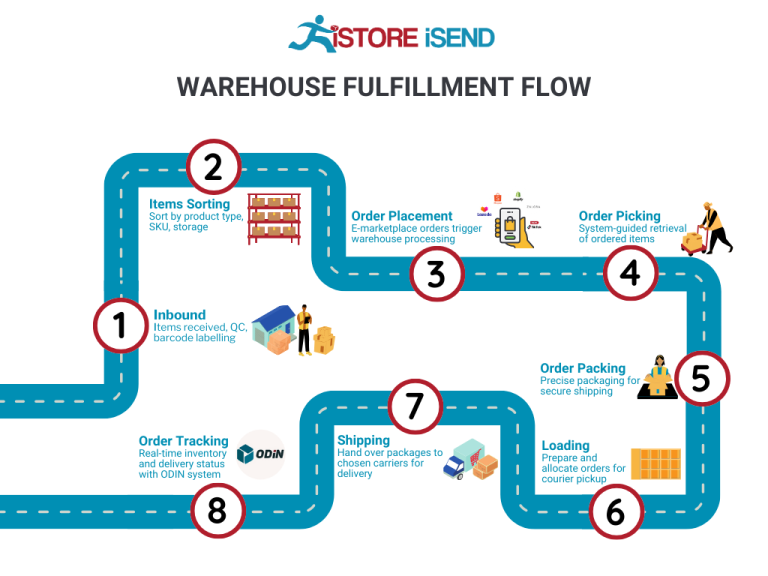
The importance of efficient order picking cannot be overstated. It directly affects order accuracy and fulfillment speed, both of which are critical to customer satisfaction. Inaccurate picking can lead to returns, increased operational costs, and a damaged reputation. Therefore, businesses should invest in training their staff and utilizing technology, such as handheld scanners and automated systems, to enhance picking efficiency and accuracy.
4. Order Packing
After the items are picked, they move to the order packing stage. Here, products are carefully packed into boxes or containers, ensuring they are secure for transit. This process often involves the use of packing slips, which detail the contents of each package and serve as a confirmation for both the business and the customer.
Packing is a vital step because it not only protects the products during shipping but also contributes to the overall customer experience. Well-packed orders reflect professionalism and attention to detail, which can significantly influence customer perceptions. Businesses should consider using eco-friendly packaging materials and methods, as sustainability is increasingly becoming a deciding factor for consumers.
5. Shipping & Delivery
The final step in the order fulfillment process is shipping and delivery. Once orders are packed, they are labeled and prepared for shipment, utilizing various carriers based on cost, speed, and destination. This stage also involves generating tracking numbers, which allow customers to monitor their orders in real-time.
Shipping and delivery are critical components of the fulfillment process as they directly impact customer satisfaction and retention. Timely delivery can differentiate a business from its competitors, especially in the e-commerce landscape where consumers expect rapid fulfillment. To enhance shipping efficiency, businesses should analyze shipping options and establish relationships with reliable carriers, ensuring they can meet diverse customer needs while optimizing costs.
By understanding and optimizing each step of the order fulfillment process, e-commerce businesses can significantly enhance their operational efficiency, improve customer satisfaction, and ultimately scale their sales and logistics effectively.

Comparing Fulfillment Models: In-House vs. 3PL vs. Dropshipping
Fulfillment Model Comparison Table
| Model | Who Handles Inventory | Best For (Business Stage) | Key Advantage | Key Disadvantage |
|---|---|---|---|---|
| In-House Fulfillment | Your business | Established businesses with stable sales | Complete control over inventory and fulfillment process | High overhead costs and resource-intensive |
| Third-Party Logistics (3PL) | 3PL provider | Growing businesses looking to scale | Access to expertise and advanced logistics technology | Less control over inventory and potential communication issues |
| Dropshipping | Supplier | Startups and small businesses | Low upfront investment and minimal risk | Lower profit margins and reliance on supplier reliability |
In-House Fulfillment
In-house fulfillment refers to the model where a business manages its own storage, inventory, and shipping processes. This approach is often favored by established companies with a steady stream of orders, as it allows for complete control over inventory management and the fulfillment process. By handling their logistics, businesses can ensure quality control, customize packaging, and create a personalized experience for their customers. However, managing fulfillment in-house can be resource-intensive. It requires significant investment in warehouse space, staffing, and technology. Additionally, as order volumes grow, operational complexities can increase, leading to potential inefficiencies. For businesses at this stage, the trade-off between control and operational overhead becomes a critical consideration.
Third-Party Logistics (3PL)
Third-party logistics (3PL) providers offer businesses a way to outsource their logistics operations, including inventory management, warehousing, and shipping. This model is particularly beneficial for growing businesses that want to scale quickly without the significant capital investment required for in-house operations. 3PL providers bring expertise and advanced technology solutions, enabling businesses to leverage efficient logistics practices and potentially lower shipping costs. Additionally, 3PL can handle fluctuations in order volume, making it easier for businesses to adapt to market demands. However, this model comes with its challenges, such as reduced control over inventory and the fulfillment process, which can lead to communication issues and potential delays. It is essential for businesses to choose a reliable 3PL partner to mitigate these risks.
Dropshipping
Dropshipping is a fulfillment model where the retailer does not keep goods in stock but instead transfers customer orders and shipment details directly to the supplier. This model is often used by startups and small businesses due to its low upfront investment and minimal risk. Retailers can offer a wide range of products without the need for physical inventory, making it an attractive option for those testing new markets or product lines. However, dropshipping does have notable disadvantages, including lower profit margins since the retailer often pays a wholesale price to the supplier, which can be significantly higher than what they charge the customer. Additionally, reliance on suppliers for inventory and shipping can lead to inconsistencies in product availability and delivery times, impacting customer satisfaction. Businesses using dropshipping must focus on building strong relationships with reliable suppliers to ensure a smooth fulfillment process.
Conclusion
Choosing the right fulfillment model is crucial for the success of any e-commerce business. Each model—In-House Fulfillment, 3PL, and Dropshipping—offers unique advantages and challenges. In-house fulfillment provides control but at a higher cost, while 3PL offers scalability and expertise but can complicate inventory management. Dropshipping minimizes risk and investment, yet it may lead to lower margins and dependency on suppliers. Understanding the specific needs of your business and evaluating your operational capabilities will guide you in selecting the most effective fulfillment strategy for your growth trajectory.
A Deep Dive into Amazon FBA: Pros, Cons, and Who It’s For
Understanding Fulfillment by Amazon (FBA)
Fulfillment by Amazon (FBA) is a service offered by Amazon that allows e-commerce sellers to store their products in Amazon’s fulfillment centers. This service simplifies the logistics of order fulfillment, allowing sellers to leverage Amazon’s extensive distribution network. When a customer places an order, Amazon takes care of storage, packaging, and shipping of the products directly to the customer. Sellers benefit from Amazon’s customer service and return handling, making it easier to manage their business.
How FBA Works
-
Account Setup: Sellers begin by creating an Amazon Seller Account and enrolling in the FBA program. This process includes agreeing to the terms of service and setting up payment information.
-
Product Listing: Sellers list their products on the Amazon marketplace and indicate which items will be fulfilled through FBA.
-
Inventory Shipment: Sellers ship their products to Amazon’s fulfillment centers. They can choose to send inventory to multiple centers based on Amazon’s recommendations to optimize shipping times.
-
Storage and Management: Once received, Amazon takes responsibility for storing the inventory. Sellers can track their inventory levels through the Seller Central dashboard.
-
Order Fulfillment: When a customer orders a product, Amazon picks, packs, and ships the order. This includes handling customer inquiries and returns.
-
Payment Processing: After the sale, Amazon collects the payment and disburses the seller’s earnings, minus the applicable fees.
Pros of Using FBA
1. Prime Eligibility
Products fulfilled through FBA are eligible for Amazon Prime, which can significantly increase visibility and sales. Prime members often prefer Prime-eligible products due to faster shipping options.
2. Customer Trust
Amazon is a trusted brand with a reputation for reliable service. By using FBA, sellers can benefit from this trust, as customers feel more secure purchasing products backed by Amazon’s fulfillment and customer service.
3. Multi-Channel Fulfillment
FBA allows sellers to fulfill orders not only from Amazon but also from other sales channels, such as their own websites or other marketplaces. This flexibility enhances operational efficiency and expands market reach.
4. Simplified Logistics
FBA simplifies the logistics of storage, packing, and shipping. This allows sellers to focus on other aspects of their business, such as marketing and product development, rather than managing warehousing and logistics.
5. Scalable Operations
As businesses grow, FBA provides a scalable solution. Sellers can increase inventory levels without worrying about storage space or fulfillment processes, allowing for rapid scaling.
Cons of Using FBA
1. High Fees
FBA involves various fees, including storage fees for keeping inventory in Amazon’s warehouses and fulfillment fees for picking, packing, and shipping orders. These fees can quickly add up, especially for sellers with low-margin products.
2. Strict Inventory Rules
Sellers must adhere to Amazon’s strict inventory management rules, including requirements for labeling, packaging, and maintaining stock levels. Non-compliance can lead to additional fees or removal of inventory.
3. Commingling Risks
FBA uses a commingled inventory system, meaning that products from different sellers may be stored together. This can pose risks, such as receiving returns for products that do not belong to the seller, potentially harming brand reputation.
4. Limited Control over Shipping
While Amazon handles shipping, sellers have limited control over the shipping process and delivery times. This can lead to issues if a seller’s brand requires specific packaging or shipping practices.
5. Dependency on Amazon
Using FBA can create dependency on Amazon’s platform, which may limit sellers’ ability to diversify their sales channels or negotiate better terms in the future.
Who is FBA Best For?
Fulfillment by Amazon is particularly beneficial for:
-
Small to Medium-Sized Businesses: Companies looking to streamline operations and take advantage of Amazon’s logistics without investing heavily in their own infrastructure can greatly benefit from FBA.
-
E-commerce Entrepreneurs: Startups and individual sellers who want to focus on product development and marketing rather than logistics will find FBA advantageous.
-
Sellers of High-Demand Products: Businesses with products that have steady demand and good margins can leverage FBA to maximize sales and take advantage of Prime membership.
-
Multi-Channel Sellers: Businesses that sell across various platforms can use FBA to centralize their fulfillment processes, allowing them to provide consistent service across all channels.
-
Brands Looking to Scale: Companies planning for growth can utilize FBA’s scalability to manage increased order volumes without significant upfront investments in warehousing.
In conclusion, Fulfillment by Amazon offers a range of benefits and challenges that e-commerce sellers must consider. By understanding how FBA works and weighing its pros and cons, businesses can make informed decisions about whether this fulfillment strategy aligns with their operational goals and growth ambitions.
Core Services Offered by Fulfillment Centers
Inventory Management & Warehousing
Inventory management and warehousing form the backbone of efficient fulfillment operations. Fulfillment centers, such as Amazon SBD2, utilize sophisticated inventory management systems to track products in real-time. This includes monitoring stock levels, managing reorder points, and forecasting demand to ensure that products are available when needed.
Benefits for E-commerce Businesses:
-
Enhanced Visibility: With real-time tracking of inventory, businesses can gain insights into stock levels and make informed decisions about purchasing and sales strategies. This visibility reduces the risk of stockouts or overstock situations, both of which can negatively impact cash flow.
-
Space Optimization: Fulfillment centers are designed to maximize space efficiency, allowing businesses to store products in a cost-effective manner. By leveraging shared warehousing space, e-commerce businesses can reduce overhead costs associated with maintaining their own storage facilities.
-
Scalability: As businesses grow, their inventory needs can change rapidly. Fulfillment centers offer flexible warehousing options that can scale up or down based on demand. This adaptability allows businesses to respond to market changes without incurring significant long-term commitments.
Pick and Pack Services
Pick and pack services are critical components of the fulfillment process, involving the selection of products from inventory and preparing them for shipment. Fulfillment centers employ streamlined processes and advanced technology to efficiently pick the right items and package them appropriately for delivery.
Benefits for E-commerce Businesses:
-
Speed and Efficiency: Fulfillment centers are equipped with optimized workflows and automation tools that significantly reduce the time taken to fulfill orders. This speed is essential for meeting customer expectations, particularly with the rise of same-day and next-day delivery options.
-
Accuracy: Using technology such as barcode scanning and inventory management software, fulfillment centers minimize errors during the picking process. Accurate order fulfillment reduces the likelihood of returns and enhances customer satisfaction.
-
Cost-Effectiveness: Outsourcing pick and pack services can lower labor costs and reduce the need for investment in packaging materials and equipment. This allows e-commerce businesses to focus their resources on growth strategies rather than operational logistics.
Kitting and Assembly
Kitting and assembly services involve grouping individual items into ready-to-sell sets or kits. This service is particularly useful for e-commerce businesses that offer bundled products or require assembly before shipping.
Benefits for E-commerce Businesses:
-
Customization: Kitting allows businesses to offer customized product bundles tailored to specific customer needs or preferences. This can enhance the customer experience and increase the perceived value of the products.
-
Streamlined Operations: By outsourcing kitting and assembly to fulfillment centers, businesses can streamline their operations. This reduces the need for in-house labor and minimizes the complexity of managing multiple SKUs.
-
Improved Inventory Management: Kitting can simplify inventory management by reducing the number of individual SKUs that need to be tracked. This can lead to greater efficiency in inventory turnover and more straightforward forecasting.
Returns Management (Reverse Logistics)
Returns management is a critical aspect of e-commerce operations, particularly in an era where customers expect hassle-free return processes. Fulfillment centers provide specialized services to handle returns efficiently, often referred to as reverse logistics.
Benefits for E-commerce Businesses:
-
Streamlined Returns Process: Fulfillment centers have established protocols for handling returns, including inspecting, restocking, or disposing of returned items. This efficiency minimizes the time and effort businesses need to invest in managing returns.
-
Data Insights: Analyzing return data can provide valuable insights into customer behavior and product quality. Understanding why items are returned can help businesses make informed decisions about product offerings and marketing strategies.
-
Enhanced Customer Satisfaction: A seamless returns process contributes to a positive customer experience. By outsourcing returns management to a fulfillment center, businesses can ensure that customers receive prompt resolutions, which can foster loyalty and repeat business.
In conclusion, partnering with fulfillment centers like Amazon SBD2 can provide e-commerce businesses with essential services that enhance operational efficiency, reduce costs, and improve customer satisfaction. By leveraging the expertise and infrastructure of fulfillment centers, businesses can scale their operations effectively while maintaining a focus on growth and customer engagement.
How to Choose a Fulfillment Partner: A 6-Point Checklist
Location & Warehouse Network
Importance: The geographical location of your fulfillment partner can significantly impact shipping times and costs. A strategically located warehouse network can facilitate faster deliveries and lower shipping expenses, enhancing customer satisfaction.
Questions to Ask:
– Where are your warehouses located, and how does that align with my target customer base?
– Do you have multiple locations to support regional distribution?
– How do you manage inventory across different warehouses to ensure product availability?
Technology & Integrations
Importance: Efficient fulfillment relies heavily on technology. A partner with advanced systems can streamline operations, automate processes, and provide real-time inventory tracking, which is crucial for maintaining optimal stock levels and fulfilling orders accurately.
Questions to Ask:
– What technology platforms do you use for inventory management and order processing?
– Can your system integrate with my existing e-commerce platform (e.g., Shopify, WooCommerce)?
– Do you provide real-time tracking for shipments, and how is this information communicated to customers?
Specializations (e.g., cold storage, oversized items)
Importance: Depending on your product types, you may require specialized services. For instance, if you sell perishable goods, your partner should have cold storage capabilities. Similarly, if you deal with oversized or fragile items, ensure they have the right equipment and expertise to handle such products.
Questions to Ask:
– What types of products do you specialize in handling?
– Can you accommodate specific storage requirements, such as temperature control or unique packaging?
– What experience do you have with my product category, and can you provide case studies or references?
Scalability & Capacity
Importance: As your business grows, your fulfillment partner must be able to scale operations accordingly. Understanding their capacity for handling increased order volumes and seasonal spikes is critical to maintaining service quality and meeting customer expectations.
Questions to Ask:
– What is your current capacity, and how do you handle peak seasons or unexpected surges in demand?
– Are there additional costs associated with scaling up my operations?
– How quickly can you adapt to my changing needs, and what processes are in place for expansion?
Pricing and Contracts
Importance: Transparent pricing and contract terms are essential for budgeting and financial planning. Understand all potential costs, including storage fees, pick-and-pack fees, shipping rates, and any additional charges that may arise.
Questions to Ask:
– Can you provide a detailed breakdown of your pricing structure?
– Are there any hidden fees or costs associated with your services?
– What are the terms of the contract, and how flexible are they regarding changes in volume or service requirements?
Customer Support & Reviews
Importance: Reliable customer support is vital for resolving issues quickly and maintaining a smooth operation. Additionally, researching reviews and testimonials can provide insights into the partner’s reputation and service quality.
Questions to Ask:
– What level of customer support do you offer, and how can I reach you (e.g., phone, email, chat)?
– What is your average response time for support inquiries?
– Can you share references or reviews from other clients, particularly those in my industry?
Conclusion
Choosing the right fulfillment partner is a critical decision that can significantly influence your e-commerce business’s success. By carefully considering each of the points outlined in this checklist, you can ensure that your chosen partner aligns with your operational needs and supports your growth objectives. Remember, a solid partnership can lead to enhanced customer satisfaction, streamlined operations, and ultimately, increased sales.
Understanding Fulfillment Pricing: A Breakdown of Common Fees
Initial Setup Fees
When partnering with a fulfillment center like Amazon SBD2, the first expense you may encounter is the initial setup fee. This fee typically covers the costs associated with onboarding your business onto the fulfillment platform. The setup process includes creating your account, integrating your e-commerce platform, and setting up product listings within the fulfillment system.
Calculation: Initial setup fees can vary widely depending on the fulfillment provider. Some may charge a flat fee, while others may base it on the number of products or complexity of the integration. It’s crucial to inquire about any additional costs that might arise during this phase, such as training or customization of services.
Receiving Fees
Once your products arrive at the fulfillment center, you will incur receiving fees. These are charged for the labor and resources needed to unload, inspect, and store your inventory. Receiving fees ensure that your products are properly accounted for and ready for order fulfillment.
Calculation: Receiving fees are usually calculated per pallet or per item, depending on the fulfillment center’s pricing structure. For example, if you send a shipment containing 20 pallets, you would pay a receiving fee for each pallet processed. It’s advisable to check the specific rates and whether there are minimum charges for small shipments.
Storage Fees (per pallet/bin)
Storage fees are incurred for the space your inventory occupies within the fulfillment center. These fees are charged on a recurring basis, typically monthly, and can significantly impact your overall fulfillment costs, especially if you are storing large quantities of products or have a slow-moving inventory.
Calculation: Storage fees are often calculated based on the volume of space your products occupy, usually measured in cubic feet or by the pallet/bin. For instance, if a pallet occupies 48 cubic feet and the storage fee is $10 per pallet per month, you would pay that amount for every pallet stored. Be mindful of any seasonal adjustments in storage fees, as some fulfillment centers may increase rates during peak seasons.
Pick & Pack Fees (per item/order)
Pick and pack fees are charged for the labor involved in retrieving items from storage and preparing them for shipment. This process includes picking the items from shelves, packing them securely, and labeling them for delivery. Efficient pick and pack operations are crucial for maintaining quick turnaround times and customer satisfaction.
Calculation: These fees are typically charged per item or per order, depending on the fulfillment center’s pricing model. For example, a fulfillment center may charge $1.50 per item picked and packed. If a single order contains three items, the total pick and pack fee would be $4.50. Some providers offer tiered pricing, where the cost per item decreases as order volume increases, so it’s beneficial to understand how your order patterns will affect these costs.
Shipping Fees
Shipping fees are one of the most variable costs associated with fulfillment services. These fees cover the transportation of your products from the fulfillment center to your customers. Various factors influence shipping fees, including the destination, shipping method, package dimensions, and weight.
Calculation: Shipping fees are generally calculated based on the carrier’s pricing structure, which may include flat rates for specific regions, weight-based pricing, or dimensional weight calculations. For instance, if you ship a package that weighs 5 pounds to a customer within the same state, the fee might be considerably lower than shipping a 10-pound package across the country. It’s vital to compare rates from different carriers and determine if the fulfillment center has partnerships that can offer discounted shipping rates.
Tips for Getting an Accurate Quote
-
Request Detailed Pricing Information: Always ask for a breakdown of fees from the fulfillment center. Understanding what is included in each fee will help you budget more accurately.
-
Analyze Your Inventory Turnover: Knowing your inventory turnover rates can help you predict storage fees more accurately. Slow-moving products can lead to higher costs.
-
Inquire About Additional Fees: Some fulfillment centers may have hidden fees, such as for returns, special packaging, or long-term storage. Clarify these costs upfront.
-
Evaluate Different Fulfillment Centers: Don’t settle for the first quote you receive. Evaluate multiple providers to compare pricing structures and services offered.
-
Consider Volume Discounts: If you plan to scale your operations, inquire about volume discounts that could lower your costs as your order quantities increase.
By understanding these common fulfillment pricing models and following these tips, you can make informed decisions that will help optimize your logistics and ultimately support the growth of your e-commerce business.
Frequently Asked Questions (FAQs) about Fulfillment
1. What is the address of the SBD2 Amazon Fulfillment Center?
The SBD2 Amazon Fulfillment Center is located at 1494 S Waterman Ave, San Bernardino, CA 92408, United States.
2. What services does the SBD2 Fulfillment Center offer?
The SBD2 Fulfillment Center specializes in storing and shipping a wide variety of products. It plays a crucial role in Amazon’s logistics network, ensuring efficient processing and timely delivery of orders to customers.
3. How does the SBD2 center impact delivery times for sellers?
The SBD2 facility is strategically located to facilitate quick shipping and receiving processes. Its advanced infrastructure is designed to handle high volumes of shipments, which can significantly reduce delivery times for sellers using Amazon’s Fulfillment by Amazon (FBA) service.
4. What are the typical operational hours of the SBD2 Fulfillment Center?
The SBD2 Amazon Fulfillment Center operates daily from 6:00 AM to 11:30 PM, allowing for flexible shipping and receiving times for businesses and drivers.
5. What should truck drivers expect when arriving at the SBD2 Fulfillment Center?
Truck drivers have reported that they may encounter long wait times when checking in and picking up loads at the SBD2 facility. It is advisable to plan accordingly and allow extra time for potential delays.
6. What is the difference between a warehouse and a fulfillment center?
A warehouse is primarily used for storing goods, while a fulfillment center is designed to manage the complete order fulfillment process, including inventory management, picking, packing, and shipping products directly to customers. Fulfillment centers often have advanced technology to streamline these operations.
7. What is a Third-Party Logistics Provider (3PL)?
A Third-Party Logistics Provider (3PL) is a company that offers outsourced logistics services to businesses. These services can include transportation, warehousing, inventory management, and fulfillment. Utilizing a 3PL can help businesses scale their operations without the need to invest heavily in their own logistics infrastructure.
8. How much do fulfillment services typically cost?
The cost of fulfillment services can vary widely depending on several factors, including the volume of products, the complexity of the fulfillment process, and any additional services required (such as kitting or custom packaging). Businesses should evaluate their specific needs and request quotes from multiple providers to find the best fit.
9. Are there safety measures in place at the SBD2 Fulfillment Center?
While the SBD2 Fulfillment Center has implemented various safety protocols, there have been reports from employees questioning the adequacy of these measures. It is crucial for businesses to inquire about specific safety practices and ensure compliance with industry standards.
10. How can businesses benefit from using the SBD2 Fulfillment Center?
By utilizing the SBD2 Fulfillment Center, businesses can leverage Amazon’s extensive logistics network, gain access to faster shipping options, and enhance customer satisfaction. Additionally, integrating with Amazon’s FBA program can help sellers reach a larger audience through Prime shipping benefits.
Conclusion: Is Outsourcing Fulfillment the Right Move for Your Business?
Evaluating the Benefits of Outsourcing Fulfillment
Outsourcing your fulfillment process can be a game-changer for your e-commerce business. By leveraging a fulfillment service, you can save significant time and resources that can be redirected toward core business activities, such as marketing and product development. This allows you to focus on scaling your operations without getting bogged down by the complexities of logistics management.
One of the most compelling advantages of partnering with a fulfillment center, such as Amazon’s SBD2 facility, is scalability. As your business grows, so do your fulfillment needs. A dedicated fulfillment partner can easily accommodate fluctuations in order volume, whether you’re experiencing a seasonal spike in sales or a steady increase over time. This adaptability ensures you can meet customer demands without the hassle of expanding your warehouse space or hiring additional staff.
Moreover, outsourcing fulfillment provides access to specialized expertise and technology that may not be feasible to implement in-house. Established fulfillment centers are equipped with advanced systems for inventory management, order processing, and shipping logistics, enabling them to operate efficiently. This expertise can enhance your customer service by ensuring faster and more reliable delivery, which is critical in today’s competitive e-commerce landscape.
However, it’s essential to choose the right fulfillment partner to support your growth. Conduct thorough research and audits of potential partners, focusing on their operational capabilities, technology infrastructure, and customer service reputation.
Take Action
As you consider whether outsourcing fulfillment is the right move for your business, take the first step by auditing your current shipping processes. Assess your fulfillment efficiency, costs, and the potential impact of partnering with a fulfillment service. By understanding your needs and the landscape of fulfillment options available, you can make an informed decision that aligns with your business goals.
Important Disclaimer
⚠️ Important Disclaimer
The information in this guide is for educational purposes. Fulfillment services, pricing, and platform features change frequently. Always conduct your own due diligence and consult with providers directly before making business decisions.
